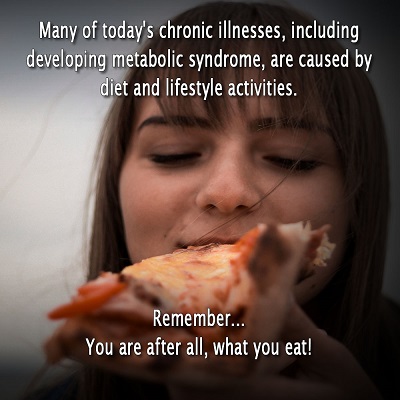 Many of today’s chronic illnesses are caused by our diet and lifestyle choices. You are after all, what you eat – if you put the good foods in, better health results.
Many of today’s chronic illnesses are caused by our diet and lifestyle choices. You are after all, what you eat – if you put the good foods in, better health results.
If you have been diagnosed or are at risk of developing metabolic syndrome, here are a few diet and nutrition tips that you can start implementing.
Get Your Daily Dose of Fiber
It’s not easy to lose belly fat, but with the right diet and nutrition, there are effective ways to do so. One important element in your diet is fiber. Fiber, specifically soluble fiber, is crucial in helping you lose unwanted and dangerous belly fat. It also helps lower your blood sugar and bad LDL cholesterol.
According to one study, a 10 gram increase of daily soluble fiber can lower your risk of gaining more belly fat by 3.7%. Great sources of soluble fiber are oatmeal, rice bran, barley, beans, lentils, carrots, sweet potato, broccoli, citrus fruits, apple, avocado, and strawberries.
Eat a High Protein Diet
Many studies show that a sustained high protein diet can effectively help with weight management and even alter the symptoms of metabolic syndrome. Just make sure to eat lean sources of protein such as beef, lamb, chicken, yogurt, tofu, nuts, fish, pork, and eggs. Limit processed meat intake. The ketogenic diet is a diet that is based on eating plenty of protein-rich foods and is also a diet followed for impressive weight loss.
Regulate Dietary Cholesterol
Dietary cholesterol is not the biggest culprit when it comes to cardiovascular disease (heart disease, atherosclerosis, etc.) as we were once told. Studies have shown that only 30% of people are vulnerable to the negative effects of dietary cholesterol in foods.
The AHA (American Heart Association) still recommends limiting daily intake of dietary cholesterol to less than 300 mg/day. One egg contains at least 200 mg of dietary cholesterol. To stay within guidelines, you can limit your daily intake of eggs, shrimp, shellfish, liver, and other organ meats.
However, you can also boost your good cholesterol (which balances the bad cholesterol) by eating delicious good cholesterol boosting foods! They include foods such as nuts and avocados.
Eat Healthy Fats & Avoid the Bad Fats
We all need fats for our bodies to be healthy! You need to eat healthy fats and avoid bad ones, so limit your intake of foods that are high in trans fats, which are mostly found in highly processed foods. If you base your diet on a keto or Mediterranean style diet, this won’t be a problem.
Limit Sodium Intake
Many packaged and fast foods contain much more than the body needs. Sodium is needed by the body, but excessive amounts can raise blood pressure levels. Salty foods generally contain sodium, but it’s also important to know that there are high-sodium foods that are not necessarily salty to taste.
Less than ¼ tsp of salt is all you need in a day. Here are some foods that are notably high in sodium and should be limited or avoided – junk foods, smoked and cured meats, salted butter or margarine, canned vegetables or soups, pasta sauces, salad dressings, sauces or ketchup, instant noodles, cake mixes, and breakfast cereals.
If You Drink Alcohol, Limit Yourself
High alcohol consumption is closely linked to metabolic syndrome. It causes lower HDL (good) cholesterol levels, a higher waist circumference, and elevated levels of triglycerides. These are all known risk factors for developing metabolic syndrome.
Alcohol is particularly associated with a beer belly. A beer typically has 150 calories, so drinking several beers at a time will cause your calorie count to escalate. Limit alcohol consumption to just 1-2 per day. This includes beer and all other alcoholic beverages.
As you can see, you really just need to cut out all sugary, processed foods, and eat a healthier diet filled with nutritious foods. As they say, ‘It’s not rocket science.’






